
Tortoises are reptiles of the family Testudinidae of the order Testudines. Like other turtles, tortoises have a shell to protect from predation and other threats. The shell in tortoises is generally hard, and like other members of the suborder Cryptodira, they retract their necks and heads directly backward into the shell to protect them.
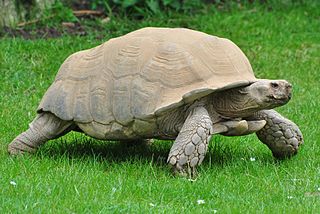
The African spurred tortoise, also called the sulcata tortoise, is an endangered species of tortoise inhabiting the southern edge of the Sahara Desert, the Sahel, in Africa. It is the largest mainland species of tortoise in Africa, and the third-largest in the world, after the Galapagos tortoise and Aldabra giant tortoise. It is the only living species in its genus, Centrochelys.

The leopard tortoise is a large and attractively marked tortoise found in the savannas of eastern and southern Africa, from Sudan to the southern Cape Province. It is the only extant member of the genus Stigmochelys, although in the past, it was commonly placed in Geochelone. This tortoise is a grazing species that favors semiarid, thorny to grassland habitats. In both very hot and very cold weather, it may dwell in abandoned fox, jackal, or aardvark burrows. The leopard tortoise does not dig other than to make nests in which to lay eggs. Given its propensity for grassland habitats, it grazes extensively upon mixed grasses. It also favors succulents and thistles.

The red-footed tortoise is a species of tortoise from northern South America. These medium-sized tortoises generally average 30 cm (12 in) as adults, but can reach over 40 cm (16 in). They have dark-colored, “loaf”-shaped carapaces with a lighter patch in the middle of each scute, and a somewhat lighter-colored plastron (underbelly). They also have dark limbs dotted with brightly-colored scales, from which they get their name, that range from pale yellow to vivid or dark red. Visible differences are noted between red-footed tortoises from varying eco-regions. They are closely related to the more easterly-distributed yellow-footed tortoise of the Amazon Basin.

Chersobius signatus is the world's smallest species of tortoise. The species is commonly known as the speckled tortoise and also known locally as the speckled padloper and internationally as the speckled Cape tortoise. A member of the genus Chersobius, it is endemic to South Africa.

The wildlife of South Africa consists of the flora and fauna of this country in Southern Africa. The country has a range of different habitat types and an ecologically rich and diverse wildlife, vascular plants being particularly abundant, many of them endemic to the country. There are few forested areas, much savanna grassland, semi-arid Karoo vegetation and the fynbos of the Cape Floristic Region. Famed for its national parks and big game, 297 species of mammal have been recorded in South Africa, as well as 849 species of bird and over 20,000 species of vascular plants.

The geometric tortoise is a critically endangered species of tortoise and one of three members of the genus Psammobates. It is found in a very small section in the South-Western Cape of South Africa.
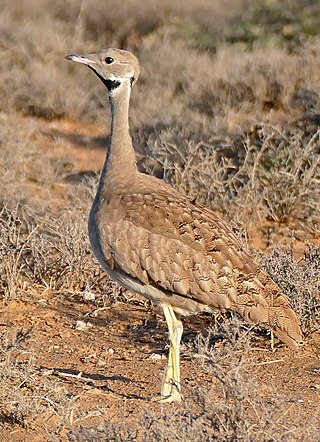
The karoo korhaan, also known as karoo bustard, is a species of bird in the bustard family, Otididae, from Southern Africa. There are two subspecies, the nominate race, from south-eastern South Africa, and H. v. namaqua, from north-eastern South Africa and southern Namibia.

Chersobius solus, commonly known as the Nama dwarf tortoise, the Nama padloper, and Berger's cape tortoise, is a species of tortoise in the family Testudinidae. The species is endemic to Namibia.

Homopus is a genus of tiny tortoises in the family Testudinidae, endemic to southern Africa. Three species have been moved to the genus Chersobius.
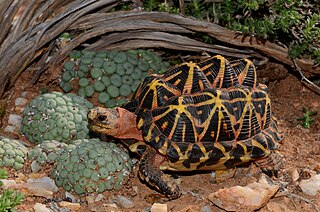
The tent tortoise is a species of tortoise and one of three members of the genus, Psammobates. Known locally as the Karoo tent tortoise, this highly variable species is found in South Africa and Namibia.
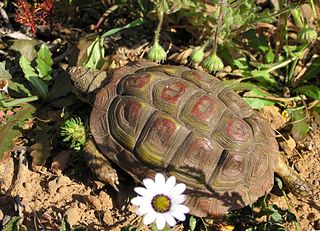
Homopus areolatus, commonly known as the common padloper or parrot-beaked tortoise, is a tiny species of tortoise of the genus Homopus, indigenous to the southern part of South Africa.

Homopus femoralis, commonly known as the greater padloper, is a small tortoise of the genus Homopus, indigenous to the highveld grasslands of South Africa.

Chersobius boulengeri, commonly known as the Karoo padloper or Boulenger's cape tortoise, is a species of tortoise in the family Testudinidae. The species is endemic to the Nama Karoo Region of South Africa.
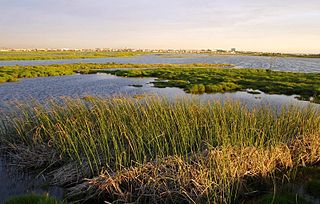
The Rietvlei Wetland Reserve is a 663-hectare (1,640-acre) nature reserve situated in Table View, Western Cape, South Africa. It is managed by the City of Cape Town's Environmental Resource Management Department.

Aloiampelos, formerly Aloe ser. Macrifoliae is a genus of succulent plants in the subfamily Asphodeloideae, comprising seven species found in Southern Africa. They are typically multi-branched climbing or sprawling shrubs, with long spindly stems and a large woody base on the ground. These characteristics, as well as their soft, narrow, triangular leaves whose lower part ensheathes the stem, make them easy to distinguish.

Durbanville Nature Reserve is a 6-hectare (15-acre) piece of protected land, located next to the Hollywoodbets Durbanville Racecourse in the Western Cape, South Africa.

The angonoka tortoise is a critically endangered species of tortoise severely threatened by poaching for the illegal pet trade. It is endemic to Madagascar. It is also known as the angonoka, ploughshare tortoise, Madagascar tortoise, or Madagascar angulated tortoise. There may be fewer than 400 of these tortoises left in the wild. It is found only in the dry forests of the Baly Bay area of northwestern Madagascar, near the town of Soalala. A captive-breeding facility was established in 1986 by the Jersey Wildlife Preservation Trust in collaboration with the Water and Forests Department. In 1996, 75 tortoises were stolen, which later appeared for sale in the Netherlands. The project was ultimately successful, achieving 224 captive-bred juveniles out of 17 adults in 2004. Project Angonoka developed conservation plans that involved local communities making firebreaks, along with the creation of a park to protect the tortoise and the forests. Monitoring of the angonoka tortoise in the global pet trade has also continued to be advocated.
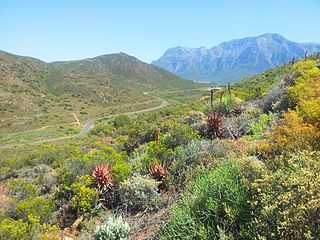
The Karoo Desert National Botanical Garden is a botanical garden focused on succulents and other plants of arid regions, that lies at the foot of the Hex River Mountains range, in the town of Worcester, South Africa.

Chersobius is a genus of tiny tortoises in the family Testudinidae, endemic to southern Africa. The genus includes the smallest tortoises in the world. All three species were previously assigned to the genus Homopus.

























